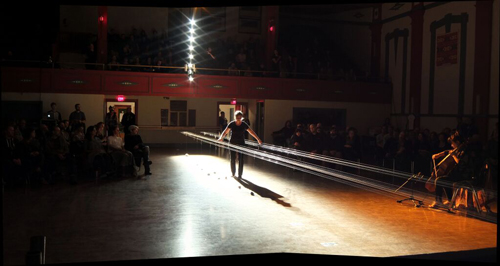by Daniel Hathaway

Audience members entered the larger of the gallery’s two spaces to find two sets of multiple wire strings stretching the length of the room, fastened at the left end to what looked like two resonating boxes, and at the right end to tuning pins. Bronze devices that resembled high-tech clothespins hung at intervals along the courses of strings to define vibrating segments. Position numbers were pasted to the floor and mysterious diagrams on loose sheets of paper were laid out under the strings.
This was the “Long String Instrument” that Ellen Fullman has spent some years developing and tweaking, and that she summons into life by running rosin-coated fingers along the length of the strings. The single work on the program on Friday was Harbors, a piece Fullman co-composed with Theresa Wong, who collaborated with a Macintosh laptop fitted out with looping software that randomly recycled the notes she played on her cello.
By way of an introduction to the piece, listeners had access to a single paragraph on cards on their folding chairs describing the three fog horns installed on San Francisco’s Golden Gate Bridge, a marvel of bureaucratic prose from the Golden Gate Bridge Highway & Transportation District. A sample:
The three horns sound as two blasts, each with a distinct tone. The lower of the two tones blasts to the west. The sequence of the two blasts is: 9-second pause starts the sequence, followed by a 1-second fog horn blast, then 2 seconds fog horns are off, then 1 second fog horns blast, then 36 seconds fog horns are off, then 1-second fog horns blast, then 2 seconds horns are off, then 1-second horns blast, then 36 seconds horns are off. This pattern continues when the fog horns are on.
After rubbing rosin on her hands and waiting out a pause while a recalcitrant recording device needed rebooting, Ellen Fullman touched one hand to each course of strings and began walking backward between them, producing eerie, jangling tones and setting up a slow motion pattern of moving back and forth while Wong played long tones on the cello.
If this sounds mesmerizing, it was — at least for the first few minutes of the 40-minute soundscape. Then, after half an hour of looped long tones, Wong introduced another texture entirely, ricocheting her bow to produce short, accented notes. This marked a musical sea change, not unlike a Noh play where the action remains static for a long period of time, then an actor makes a subtle gesture that by comparison seems seismic in its import. Not long afterward, Fullman also changed her routine, playing the strings at the left-hand side with open palms to produce short bursts sound. Some said afterwards that they took those to represent the fog horns.
Despite its impressive appearance as a gallery installation, the “Long String Instrument” is limited to a very narrow range of pitches. Like the theremin, it seems to be constrained to a few musical effects. If it can produce more variety than we heard on Friday evening, some examples would be intriguing to hear.
Published on ClevelandClassical.com September 29, 2015.
Click here for a printable copy of this article


